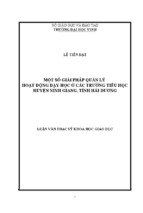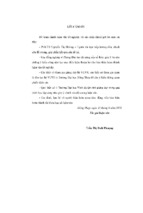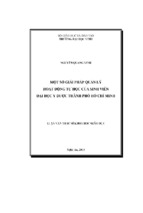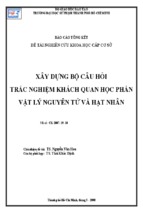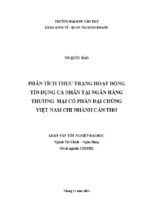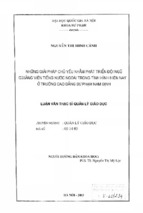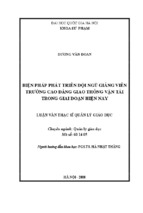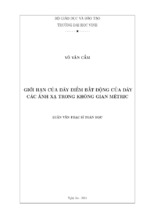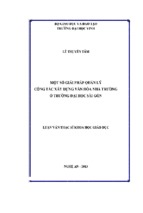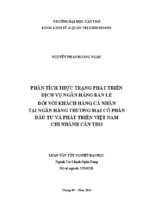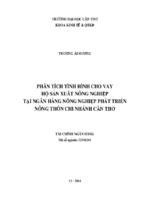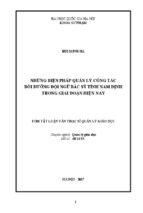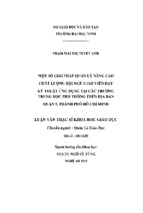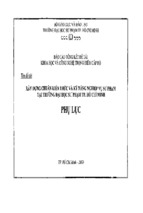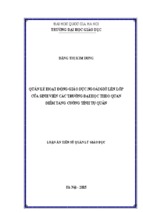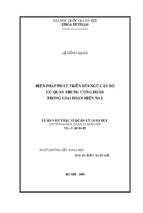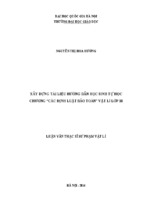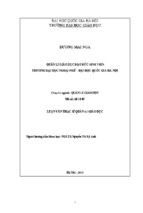-1MINISTRY OF EDUCATION AND TRAINING
UNIVERSITY OF DANANG
NGÔ THỊ BÍCH HÀ
-2The study has been completed at College of Foreign Languages,
University of Danang
Supervisor: TRAN QUANG HAI, Ph.D.
Examiner 1: Assoc. Prof. Dr. TRAN VAN PHUOC
A STUDY OF PRE-SEQUENCES IN
INVITATION IN ENGLISH AND VIETNAMESE
Examiner 2: Assoc. Prof. Dr. LUU QUY KHUONG
Field: THE ENGLISH LANGUAGE
Code: 60.22.15
M.A. THESIS IN THE ENGLISH LANGUAGE
(A SUMMARY)
The thesis was defended at the Examination Council for the M.A.
theses, University of Danang.
Time: 22/10/2010
Venue: University of Danang
Supervisor: TRAN QUANG HAI, Ph.D.
DANANG – 2010
The original of this thesis is accessible for the purpose of reference at:
- Library of the College of Foreign Languages, University of Danang.
- The Information Resources Center, University of Danang.
-3-
-4-
CHAPTER 1
INTRODUCTION
of receiving a bad sign, they can save their invitation. Therefore, both
the speakers and the hearers will not feel unpleasant, they still
1.1. RATIONALE
maintain the good relationship.
Communication is the prerequisite to maintain social
Moreover, each language contains its specific cultural features
relationships, language is the most effective and practical means of
of each country. People from different cultures are studying
communication. People use language to exchange information or
languages of other cultures, even it is absolutely different from their
convey their ideas or feelings such as ordering, promising,
cultures. In many cases, non- native speakers and native speakers fail
complaining etc and invitation is indispensable.
to understand each other that cause unpleasant, offensive problems
To have successful conversations, each interlocutor has to
although they have good wills. There are variety of ways that the
perform some conversational principles such as the cooperative and
speakers express the invitation. They are determined by cultural-
the politeness principles. Among them, politeness plays an important
based. The illocution force behind a particular invitation might differ
role in making utterances in communicative process. Evenly, it also
completely from one culture to another. The learners invite their
contribute in helping speakers decide whether or not to produce the
teachers to join a party and they say:
first pair part of the base sequence in order to avoid failure in
Vietnamese: Sir, today, on the occasion of the Vietnamese
communication.
Teachers’ Day, we have prepared a small party. We
would like to invite you to our dinner.
When using invitations, most speakers especially Vietnamese
may often use pre-sequence as a polite strategy as well as a safe
strategy. We can take this example as a proof:
A: Are you busy right now?
British:
Could you please to come to our dinner for the
celebration of the Vietnamese Teachers’ Day?[15,
(pre-sequences)
B: No, why?
A: I’m baking a cake now. Won’t you come over? [54, p116]
In this conversation, the speakers use pre-sequence to survey if
their invitation can be accepted. If they receive a good sign from the
hearers, they will continue to give the official invitation. In the case
p47]
We can see that Vietnamese use Pre-sequence to give a reason
before they give an official invitation. It can be also seen as a polite
strategy because it can express their respect to their teacher while the
British do not use pre-sequence in their invitation. From the above
example, it reveals that there is a different cultural thought patterns.
-5Therefore,
it
inevitably
happens
-6cross
–culture
when
we
communicate and in some cases the invitation fails.
For these above reasons, I would like to choose “A study of pre-
- Contrast the syntactic and functional features of this speech act in
English and Vietnamese to find out the similarities and differences
between the two languages.
sequences in invitation in English and Vietnamese” as the topic of
- Suggest some implications of the findings for the teaching and
my M.A in the hope of making some contribution to the development
learning of English and Vietnamese as foreign languages.
of learners’ skills as well as the process of teaching and learning
1.3. RESEARCH QUESTIONS
English when we have to deal with pre-sequences in invitation.
1.2. AIMS AND OBJECTIVES
1.2.1. Aims of the Study
This study is carried out with the aim at helping the Vietnamese
learners of English acquire knowledge of pre-sequences in invitation
The study will clarify the following questions:
1. What are the typical structures of Pre invitation sequences in
English and Vietnamese?
2. What are the functional features of Pre-invitation sequences in
English and Vietnamese?
and use them more effective in appropriate situations. Moreover, the
3. What are the similarities and differences between English and
finding of the study will help the learner to use of pre-sequences in
Vietnamese in the syntactic and functional features of Pre-
invitation effectively in communication.
invitation sequences?
1.2.2. Objectives of the Study
1.4. THE SIGNIFICANCE OF THE STUDY
In order to have a good insight into Pre-sequences in invitations,
The author hope that the study will be able to provide useful
syntactic and functional features of Pre-sequences in invitation are
knowledge to enable better use of PIs in cross – cultural
analyzed carefully.
communication in English and Vietnamese. The findings of the study
-
can be the potential source for the teaching and learning PIs in
point out the most typical structures of Pre-sequences in
invitations used in English and Vietnamese.
English and Vietnamese in particular as foreign languages.
- Analyze the functions of Pre-sequences of invitations in terms of
1.5. THE SCOPE OF THE STUDY
strategy involving politeness.
This research is carried out by analysis the syntactic and
functional features of pre-sequences in invitation in English and
-7-
-8-
Vietnamese. The analysis of the data collected from textbooks, short
and the using pre-sequences considering as the perspective of
stories, novels and films.
politeness.
Within the scope of the study, response of invitation as well as
In Vietnamese, Pre-invitation sequences were cursorily stated in
non-verbal aspects such as facial expressions, tones and body
the books “Ngữ Dụng học”(1998) by Nguyen Duc Dan. The author
language are not included.
also mentions pre-sequences and considers them as conversational
1.6. ORGANIZATION OF THE STUDY
openings. He points out the functions of using pre-sequences such as
The study is organized into five chapters: Chapter 1 is Introduction;
surveying or making a favorable atmosphere before starting the
Chapter 2 is Literature Review and Theoretical Background; Chapter
conversation.
3 is Methodology and Procedure; Chapter 4 is Findings and
Besides, there are some dissertations of Vietnamese learners
Discussions; Chapter 5 is Conclusions
about invitation and pre-invitation sequences and some related issues
CHAPTER 2: LITERATURE REVIEW
to our study which can be listed as Lưu Quý Khương [8,9] Trương
AND THEORETICAL BACKGROUND
2.1. LITERATURE REVIEW
Speech acts have been researched by many linguists, among of
Thị Ánh Tuyết [46], Nguyễn Quang [15].
2.2. THEORETICAL BACKGROUND
2.2.1. Syntactic features
them are Yule and Cutting with many precious theories of this field.
2.2.2. Speech act theory
Cutting in “Pragmatics and Discourse” [28, p31-p39] discusses and
2.2.3. Conversational theory
points out the purposes of using pre-sequences. He states that Pre-
2.2.4. Politeness theory
sequences prepare the ground for a further sequence and signal the
2.2.5. Pre-sequences, Invitation and Pre-invitation
type of utterance to follow and they also be used with a negativeface-saving function
2.2.5.1. Pre-sequences
According to Schegloff (1990)[43, p156] “one job pre-
Yule [50] in “Pragmatics” discusses in detail pre-sequences as
sequences are designed to do is to explore the likelihood that
pre-invitations, pre-requests, and pre-announcements. He states that
utterance being prefaced, and the action(s) it will do, will not be
the concept of face saving may be helpful in understanding how
responded to in a disprefered way- will not for example be rejected”.
participants in an interaction inevitably understand more than is said
-9In other words, pre-sequences are used to help participants avoid
embarrassing disprefered responses.
- 10 3.2. DATA COLLECTION
The data used in the study were picked out from about 528
2.2.5.2. Definition of invitation
conversations from short stories, novels, books, films in both English
The Oxford dictionary of English [45, p.961] defines “invite”
and Vietnamese.
(verb) as “to make a polite, formal, or friendly request to someone
to go somewhere or to do something”.
3.3. DATA ANALYSIS
The samples collected were described qualitatively in terms of
2.2.5.3. Pre-sequences in invitation
syntactic and functional features according to modern linguistic
According to Yule [50, p133] “A Pre-invitation is an utterance
points of view in English and Vietnamese.
before an invitation to check if an invitation can be made”
Nguyễn Thiện Giáp [7, p87], Pre-sequences are called “những
lời ướm trước”. He states that “Mở ñầu cuộc thoại thường có chức
năng gây chú ý ñể ñối phương cảm thấy sẽ có một hoặc một chuỗi lời
The frequency of structures used for pre-invitation sequences
was totalized basing on the quantitative method.
The syntactic and functional features of pre-invitation
sequences were then summarized in some tables.
tiếp theo; những câu có tính chất thăm dò ñối phương về chủ thể, về
The contrastive method was applied to analyze the similarities
quan hệ, về cách thức giao tiếp. Như vậy, những lời chào, những lời
and differences in the syntactic and functional features of pre-
hô gọi, những lời thưa gửi, làm quen…là những lời mở ñầu”.
invitation sequences in the two languages. Some generalizations and
CHAPTER 3
METHODOLOGY AND PROCEDURE
3.1. RESEARCH DESIGN
implications were drawn out after the data analysis.
3.4. PROCEDURES
Firstly, pre-invitation sequences in conversations were
The research is studied according to qualitative approach that
collected; secondly, the samples were categorized into groups on the
is the combination between descriptive and contrastive methods to
basis of the syntactic features; thirdly, we analyzed the syntactic and
describe and analyze the syntactic and functional features of pre-
functional features of pre-invitation sequences in both languages;
invitation sequences in English and Vietnamese. The quantitative
fourthly, the similarities and differences of pre-invitation sequences
approach is also used in order to summarize the frequency of
in English and Vietnamese were identified and then summarized;
structures used for pre-invitation sequences.
fifthly, some implications for teaching and learning of pre-invitation
- 11 -
- 12 -
sequences for the Vietnamese learners of English as well as some
other issues for further research were suggested after the conclusion
Declarative Questions
(20)
Blade: You getting tired?
was briefly reviewed.
Jean: Uh, he’s got so much energy he wears me out
3.5. VALIDITY AND RELIABILITY
sometimes.
CHAPTER 4
Blade: Could I take you out to lunch?
FINDINGS AND DISCUSSIONS
[102]
Tag questions: Its significance of a question comes from the
4.1. THE SYNTACTIC FEATURES OF PRE-INVITATION
tag, which has the construction of an auxiliary a predicator followed
SEQUENCES IN ENGLISH AND VIETNAMESE
by a personal pronouns as the subject.
4.1.1.
The
syntactic
representation
of
pre-invitation
sequences in English
4.1.1.1. Pre-invitation sequence as a word
4.1.1.2. Pre-invitation sequences as a sentence: Declaratives,
Interrogatives, Imperatives, Exclamatives.
- Declarative structure (positive declarative)
- Interrogative statements: containing subtypes such as Yes/
No questions, Information questions, Declarative questions and
Tag questions.
Sylvia: You like salad, don’t you?
The man:
Yes
Sylvia: I’ll make a nice salad. Come!
[61, p193]
- Imperative: beginning with a verb or verb phrase and exist in
both affirmative and negative forms.
4.1.1.2. Pre-invitation sequences one more sentence
4.1.2.
The
syntactic
representation
of
pre-invitation
sequences in Vietnamese
4.1.2.1. Pre-invitation sequence as a phrase
Yes/ No question: including subtypes: Complete questions,
Incomplete questions
Information questions
(17)
(19)
M:
What’s your plan today?
An:
I can’t decide what to do
M:
How about visiting the Great Wall with me?[55, p99]
4.1.2.2. Pre-invitation sequences as a sentence: Declaratives,
Interrogatives, Imperatives, Exclamatives.
- Declaratives:
two forms : affirmative and negative
statements.
Negative statements in Vietnamese are typically formed with
words which have negative meanings such as “chả”, “chẳng”.
- 13 -
- 14 -
(34) Người nhà quê: Chả mấy khi gặp người tử tế như ông, nếu
Tag questions: In tag question, normally, we can find out the
ông không cho tôi ñược cảm ơn, thì tôi ân
phrases “ phải không, có phải không, ñược không, ñúng không” in
hận mãi. Nào, mời ông, xin ông ñừng từ chối,
the position of the end in the sentences.
phụ lòng tôi.
[70, p499]
- Interrogative statements: containing subtypes such as Yes/
No questions, Information questions, Declarative questions and
Tag questions and Alternative questions.
Yes/ No question: including subtypes: Complete questions,
Incomplete questions. Their structures contain auxiliary verbs namely
be, have, do/does before the subject of the sentence.
Information questions: the form of statement with indefinite
words in their proper positions where the required information goes
in declarative sentences: Cái gì, ở ñâu, nơi nào, khi nào, lúc nào, ai,
tại sao, cái nào, thứ nào, như thế nào, ra sao, sao, bao lâu, bao xa,
mấy giờ….They are also added some final particles such as nhỉ, chứ,
thế, vậy…
(41)
Hạnh:
Bây giờ bạn ñịnh ñi ñâu?
Văn Châu:
Đi về
[63, p688]
without final particles
combined by coordinator “hay, hay là”
- Exclamatives: The final particles are found out in the
sentences “nhỉ, thay, lắm, thế” or interjections “ôi!, ồ!, trời!, quý
hóa quá! ủa”…and some adverbs such as “ghê, quá, biết bao”..
- Imperatives: The prototypical imperatives have no subject or
a finite
4.1.2.3. PIs more than one sentence
4.1.3. Similarities and differences of syntactic representation
of pre-invitation sequences in English and Vietnamese
4.1.3.1. Similarities
4.1.3.2. Differences
4.2. THE FUNCTIONAL FEATURES OF PRE-INVITATION
SEQUENCES IN ENGLISH AND VIETNAMESE
4.2.1. The functional representation of pre-invitation
Hạnh: Hay là bạn ghé qua nhà Hạnh chơi chốc nữa hẳn về.
Declarative Questions:
Alternative questions: containing two polar questions
sequences in English
4.2.1.1. Surveying: Pre-invitation sequences with surveying
appearing in the affirmative form
function are seen as an expression of the speaker’s intention. Through
it, he/she can search the hearer’s plans, intentions, attitude, hope…
- 15 -
- 16 4.2.1.11. Drawing the hearer’s attention: This function of pre-
4.2.1.2. Notifying
(74)
A:
I’m going to an art exhibition this Saturday.
invitation sequences can be found in the situations which the
B:
Sound great.
speakers call the hearer’s name or giving a sign of starting a
A:
Would you like to go with me?
[52, p472]
talk next.
4.2.1.3. Reasoning
4.2.1.12. Giving one’s idea (commenting
4.2.1.4. Confirming
(78)
A:
Are you done with that article yet?
B:
Just finished. Why?
conversation so that the hearer concentrates what they are going to
4.2.1.13. Advising: The function advising in the Pre-invitation
sequence helps the listeners to realize what they should to do.
4.2.1.14. Showing one’s desire
A: Well, wanna take a break and go for a ride? [122]
4.2.1.5. Persuading
4.2.1.15. Reminding a good experience
(95) Salli: Do you remember when we went to Robert Frost’s cabin?
4.2.1.6. Advertising
The man:
4.2.1.7. Introducing: The speaker introduces themselves to the
listener before making an invitation so that the hearer knows who
Salii: Well, when you come back from Missouri, I’d like us
togo to Robert Frost’s cabin again.
he/she is. In addition to, identifying the speaker makes the belief to
[62, p79]
4.2.1.16. Warning
the hearer.
4.2.1.17. Showing a good will to the hearer.
4.2.1.8. Showing the honor to the listener:
(86) Playist:
Yes, I do and surely I did.
It’d really mean a lot to us if you come over a little
Vietnamese
early and we got to go to over some leads
4.2.2.1. Surveying
Blade: Um…
Playist: Please join with the band
4.2.1.9. Explaining
4.2.1.10. Suggesting
4.2.2. The functional features of pre-invitation sequences in
[102]
(99)
Kinh: Biết hút thuốc lá không nào?
Khuê:
Có ạ
Kinh:
Đây, ông hút thuốc lá, mình hút thuốc lào.[69, p297]
- 17 -
- 18 -
4.2.2.2. Notifying: The speakers want the listeners to get
information or news so that the hearers can understand or guess what
Giàng Súng: Làm gì có.
Thế thì mời cụ phó chủ tịch ạ. Bỏ thuốc phiện thì
Lão Sếnh:
the speakers want to say later.
con mèo, con gián, con mối nhà tôi nó cũng phản
ñối ñấy.
4.2.2.3. Reasoning
4.2.2.4. Confirming
[82, p513]
4.2.2.9. Showing the honor to the listener
(111) Bà cụ: Nói thế chứ những thứ này cậu Phán ăn sao ñược?
(133) Bẩm các cụ, chả mấy khi các cụ có lòng chiếu cố ñến chơi
Cậu có ăn thì lại vào cao lâu.
nhà chúng cháu. Gọi là có chén rượu nhạt, xin rước các cụ cứ
Cậu Phán: Cao lâu cũng không ngon bằng hàng của cụ.
thật thà ñi cho.
Bà cụ:
Vậy cậu mua ñi cho tôi vài hào.
[66, p271]
4.2.2.10. Showing the good will to the hearer
4.2.2.11. Explaining
4.2.2.5. Advertising
(115) Nga: Đậu phụ vẫn còn nóng, trắng mịn chẳng khác gì hàng
ñậu ngon ở nhà ñâu anh ạ. Anh lấy mấy bìa mở hàng,
em ñể rẻ cho.
[66, p133]
[88, p314]
4.2.2.12. Advising
(140) Việt: Tuyết rơi dày như thế này có lẻ chị và cháu không về
ñược ñâu. Cháu Nam lại dang sốt, nhất ñịnh ra ngoài
4.2.2.6. Persuading
sẽ rất nguy hiểm. Hai mẹ con nên nghĩ lại ñây. Đừng
4.2.2.7. Giving one’s ideas (commenting
ngại.
[88, p323]
Ở Hà Nội mà không biết bún mọc thì tẩm lắm,
4.2.2.13. Reminding a good experience
Phượng ạ.
4.2.2.14. Suggesting
Phượng: Nhưng mà…
4.2.2.15. Introducing
(121) A:
A:
Nhưng mà cái gì! Tôi khao!
[83, p171]
(144) Kiều Vân: Chào cô Xuân, cho phép tôi ñược giới thiệu Tôi là
Kiều Vân phụ trách tài chính ở ñây.
4.2.2.8. Warning
(128) Lão Sếnh: Ông sợ mất chức phó chủ tịch nên không dám
hút? Nhưng thế không hợp mệnh trời ñâu, ông
Giàng Súng ạ.
Cô Xuân: Chào cô Kiều Vân.
Kiều Vân:
Trưa nay chị có rảnh không vậy? Tôi mời chị ñi ăn
trưa ñể chúng ta làm quen.
[107]
- 19 -
- 20 -
4.2.2.16. Showing one’s desire
13. Advising
1
0.37
8
3.05
4.2.2.17. Drawing the hearer’s attention
14. Reminding a
good experience
1
0.37
8
3.05
15. Showing one’s
desire
1
0.37
1
0.39
16. Warning
1
0.37
14
5.34
17. Showing a good
will to the hearer.
1
0.37
10
3.81
Total
266
100
262
100
4.2.3. Similarities and differences of functional
representation of Pre-invitation sequence in English and
Vietnamese
Table 4.9: Summary of relative frequency ( % ) of functional
representation of Pre-invitation sequences in English and
4.2.3.1. Similarities
Vietnamese
Types of function
English language
Vietnamese language
Number
Frequency
(%)
Number
4.2.3.2. Differences
CHAPTER 5
Frequency
(%)
1. Surveying
65
24.41
48
18.32
2. Notifying
46
17.27
36
13.74
3. Reasoning
38
14.26
27
10.3
4. Confirming
31
11.63
24
9.16
CONCLUSIONS
5.1. CONCLUSIONS
With the result of data analysis and the comparison of
similarities and differences in Pre-invitation sequence in both
languages English and Vietnamese, I would like to make some final
5. Persuading
17
6.37
19
7.25
6. Advertising
16
6.01
22
8.39
7. Introducing
13
4.81
4
1.51
8. Showing the
honor to the
10
3.71
11
4.19
remarks and implications in reference to their syntax and function.
1. Syntactically
At first, Pre-invitation sequences in both languages can appear
in many structures. For instance, a word, a sentence and more than
listener
one sentence. In addition, PIs as a sentence have many forms such as
9. Explaining
9
3.36
9
3.43
10. Suggesting
8
3.00
5
1.90
11. Drawing the
hearer’s attention
5
1.83
1
0.39
12. Giving one’s
idea
4
1.49
15
5.72
Declaratives, Interrogatives, Imperatives, Exclamatives. It means that
PIs are popularly used in English and Vietnamese
Furthermore, mood relates the proposition to its context in
speech event. Each mood type is basically associated with an
- 21 -
- 22 -
illocutionary act. Linguistically, specific functions of PIs are realized
Vietnamese typically have the form of a declarative with indefinite
in the selecting mood, voice, modal element and certain expression in
words and positions in the questions.
English. In Vietnamese, function words or expressions and their
arrangement in the sentence are essential means.
In addition, we can recognize that all structures in both
languages contain modifying acts as pre-modifying (greeting or
vocative) or post- modifying (vocative)
English exploits mood, word forms and intonation for
distinction of clause types. In Vietnamese, the use of particles,
functional words and word combination take the role.
Finally, the British tend to prefer to use imperative structures
than the Vietnamese. Probably, the directness seems to be more
Finally, Pre-invitation sequences not only have one sentence
favored in this culture. Whereas, the Vietnamese use the exclamative
but also many sentences or they take many turns. The speakers can
structures more frequently than the English since this structure is
use many structures to express their intentions. Depend on different
quite expressive and it therefore can help them to show their feeling
situations, hearers, aims they intend, they might use different ways to
and attitude precisely.
impact the listeners so that the listeners know ambiguously or clearly
2. Functionally, Pre-invitation sequences have many different
what the speakers want. Using PIs more than one sentence helps the
functions in English and Vietnamese such as Surveying, Notifying,
invitation to be more powerful and effective.
Reasoning, Confirming, Persuading, Advertising,
Introducing,
Although Pre-invitation sequences in both languages share a
Showing the attitude/ the honor to the listener, Explaining, Drawing
lot of similar features, we can still find a significant number of
the hearer’s attention, Reminding a good experience, Showing one’s
differences.
desire, Giving one’s ideas, Warning, Introducing one’s self,
The results reveal that mood in English is grammatically
Suggesting. It means that using PIs is necessary in communication.
formed by the order of the subject and the finite. But in Vietnamese
PIs in English and Vietnamese can have a variety of functions
mood are lexically recognized by typical markers, particularly by
such as Surveying, Notifying, Reasoning, Confirming, Persuading,
typical words or modal particles.
Advertising, Introducing, Showing the attitude/ the honor to the
Moreover, Interrogative mood in English is usually formed
listener, Explaining, Drawing the hearer’s attention, Reminding a
with the inversion of the finite operator or modal finite and the
good experience, Showing one’s desire. It means that PIs are
subject of the sentence. In contrast, information questions in
popularly used in English and Vietnamese.
- 23 -
- 24 -
Furthermore, forms of the structures of different functions are
warms all relationships and makes favorable air in communication.
realized to be analogous in two languages. For examples,
Therefore, PIs with the above functions such as giving one’s idea,
Interrogatives for surveying function and confirming, declaratives for
warning, showing a good will, advising and reminding is a good way
notifying, reasoning and advertising, reminding a good experience in
to show the speaker’s affection to the hearer. So that, Hs feel the
Interrogatives.
honesty from Ss. It makes the inviting act is more powerful and
Both Vietnamese and British people, searching information
effective.
from the hearers such as their plan, their intention, their interest is the
We can realize Vietnamese people like to use PIs with many
most popular way to make PIs. It makes both the speaker and hearer
different functions and are distributed quite equally. While English
feel free or comfortable in inviting as well as reacting to the
people might use popular PIs like surveying, confirming, notifying
invitation. Therefore, it can minimize the addressee’s face threats.
and reasoning. This is further proof of what has been claimed as the
Besides some similarities in functional representation of Pre-
value of face in the two languages. Vietnamese people tend to be
invitation sequence in English and Vietnamese, we also find out
more careful about the way they use PIs. Vietnamese people consider
differences in functional representation of PIs.
invitation as a privilege. Accepting invitation without thinking is
Firstly, we can see that there are a few functions of pre-
considered as greedy person. So they might refuse the invitation at
invitation sequences which can appear more frequently in English
the first time, and the speakers invite one more time or use the variety
than in Vietnamese and other wise. For instance, PIs with Introducing
of structures as well as functions of PIs to show their good will to
one’s self function in English appear more than those in Vietnamese.
the listeners.
English people have a habit of introducing themselves to others or
5.2. IMPLICATIONS FOR TEACHING AND LEARNING OF
they are willing to invite the strange one to do something at the first
ENGLISH
time after introducing themselves or starting a conversation with
some savoir vivre. On the contrary, Vietnamese people seem to be
more cautious.
5.2.1. Implication for the learners
In order to succeed in making an invitation, learners should use
appropriate structures as well as functions. Learners should know the
It can be said that Vietnamese belongs to Asian culture, where
purpose of using Pre-invitation sequences, from that they can choose
sentiment and affection are important. The relationships among
the most appropriate structures or functions to get their aims
persons to persons are highly expected. Showing the caring to others
effectively. Moreover, learners should realize the differences in using
- 25 -
- 26 -
PIs in both languages English and Vietnamese. So that they can
The corpus was built with limited samples of Pre-invitation in
minimize the risk of cultural sock when they give an invitation.
English and Vietnamese from textbooks, novels, short stories, films.
Learners should study to speak not only grammatically, but also
We could not conduct a fieldwork to collect authentic samples of PIs
appropriately to achieve communicative goals.
used in everyday conversations.
The study has just addressed the issues of Pre-invitation
5.2.2. Implication for the teachers
Teachers should introduce some similarities and differences in
sequences in syntactic and functional features in English and
giving an inviting act in both languages in English and Vietnamese.
Vietnamese. Other elements such as voice, intonation, tone playing
So that learners know necessity of using PIs and know how to use
important role in producing PIs have not been considered yet.
properly. The most important is that teachers should remind learners
Finally, using pre-invitation sequences in both languages is
when giving PIs, learners should orient to the using of the target
effected by social factors such as age, social positions, power, sex,
language. They should not translate words by words from
profession, education, income…but they are not mentioned in this
Vietnamese in English. Teachers should have many class activities
study.
relating making an invitation and they need to create a teaching
5.4. SUGGESTIONS FOR FURTHER RESEARCH
environment with real life situations so that learners can practice
This study has been an attempt at analyzing the syntactic and
using Pre-invitation as much as possible. For each purpose of
functional features of PIs in English and Vietnamese with the main
invitation, teachers encourage learners to speak what they think.
purpose to find out the similarities and differences in using PIs
After that, they give some feedbacks for using appropriate structures
between the two languages. However, within the limitation of a M.A
and functions in order to communicate effectively.
thesis, a full description of this speech act cannot be done. In order to
5.3. LIMITATIONS
gain better results and provide much valuable knowledge about Pre-
The research has been carried out with our great effort.
However, it certainly cannot avoid some weakness due to the
researcher’s limitation of time, knowledge, materials and other
objective factors.
invitation sequence in English and Vietnamese for the learners of
English. The following are suggested for further study:
- Pragmatic and cultural aspects of pre-invitation sequences in
English and Vietnamese.
- Pre-invitation sequences in non- verbal communication.
- Xem thêm -

